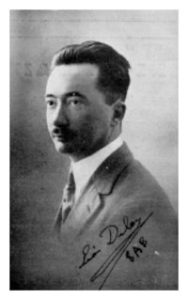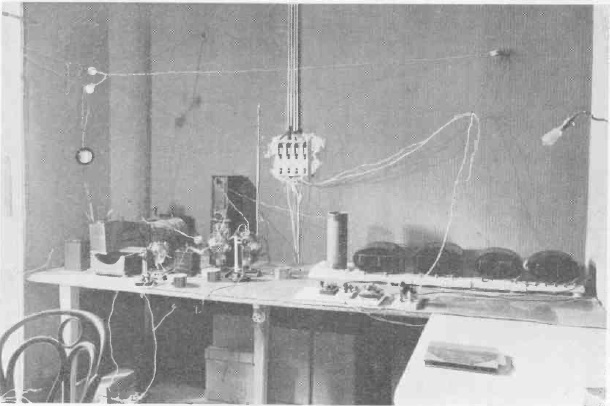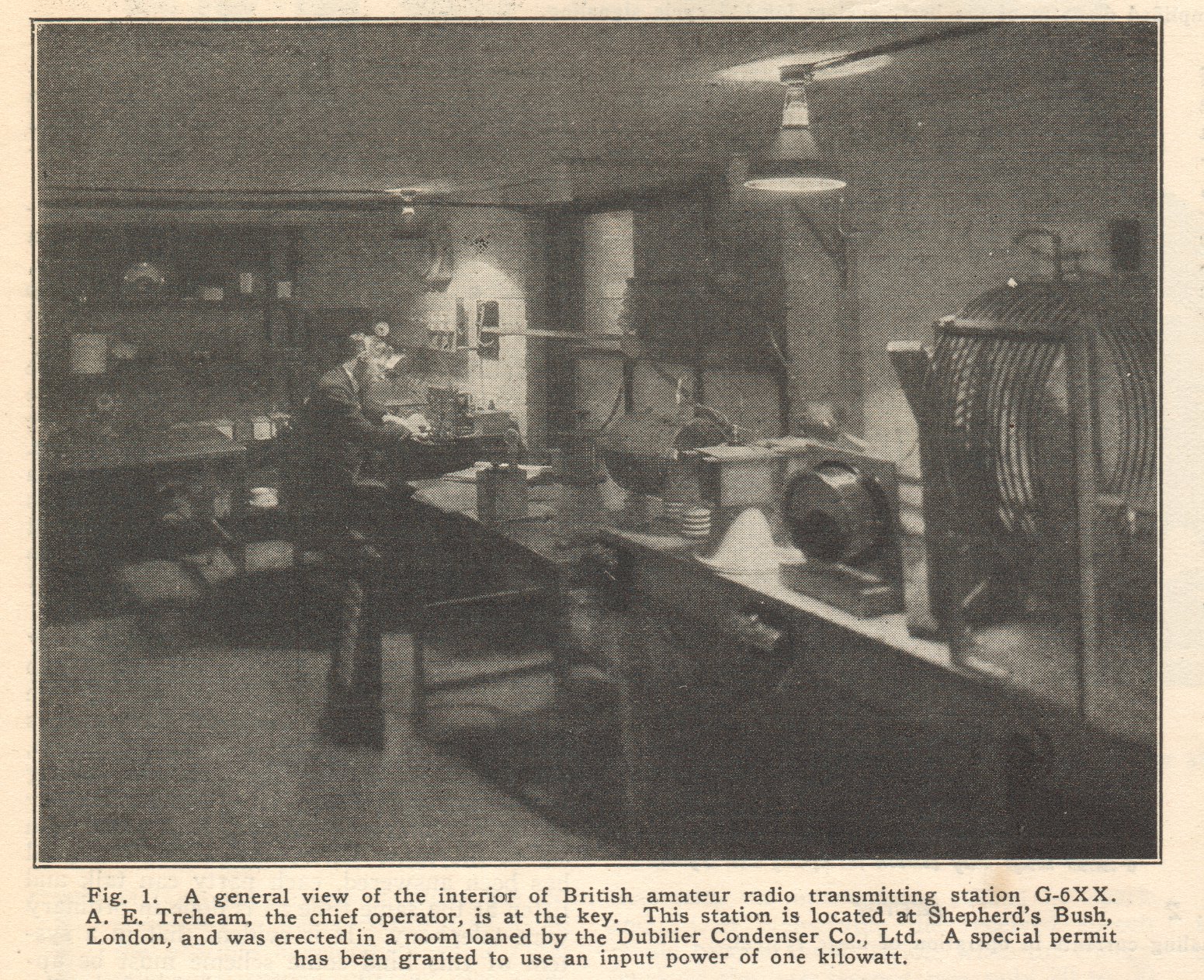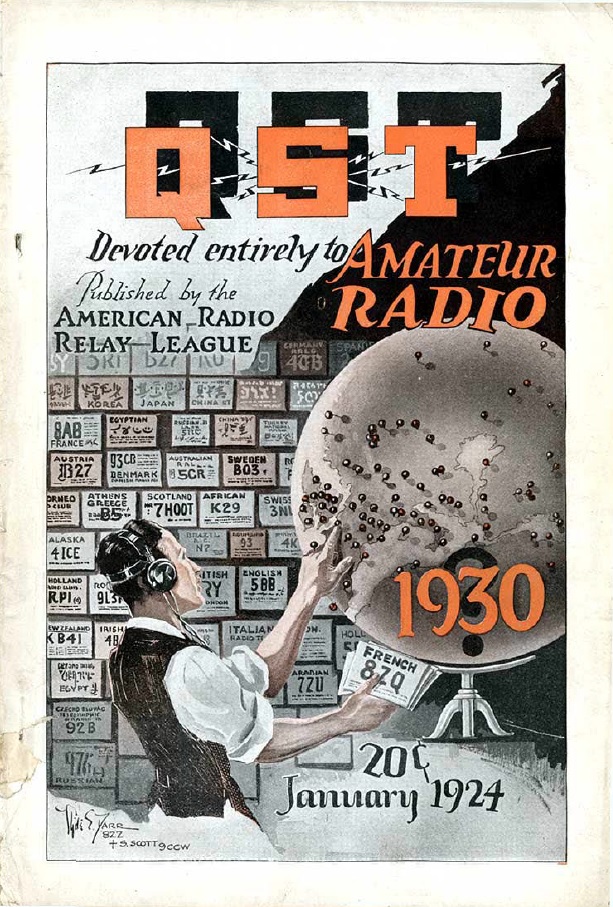Transatlantic Tests 4
Two-way Transatlantic Amateur Communication Achieved
In December 1922, amateur signals were heard in both directions across the Atlantic, amateurs were still using wavelengths around 200 metres and high power was needed to get across. We can only marvel at what these early amateurs achieved using wavelengths that are now part of the AM medium-wave band.
Meanwhile, prior to the third Tests, in January 1922, a US amateur, Boyd Phelps, made tests at 9ZT in Minneapolis, to determine the minimum wavelength to which a 100 watt tube transmitter, could be tuned. He achieved good antenna currents down as far as 35 metres but nobody was yet listening on that wavelength. His article in QST March 1922 explains:
The general amateur station license provides for wave lengths “not exceeding 200 meters” which leaves a vast number of available waves below this limit. There is really an infinite number of wave lengths available and on the lower waves tuning is so sharp that several meters difference in wave length is sufficient to completely tune out a station.
Looking at the situation in a broadminded fashion, it appears ridiculous that out of the immense number of possible adjustments we should all strive for the same one (namely 200 metres).[1]
Tests were conducted at shorter wavelengths over the following year but few stations made the move. Around 1921, John Reinartz 1XAM developed a new receiver circuit, called the Reinartz Tuner. The unit had an unheard of tuning range from 200 meters down to 28 meters. Construction information was published in QST and numerous other magazines. Thousands of experimenters built the receiver.
QST, December 1923, tells of Leon Deloy’s visit to the US during which he studied the methods being used by US amateurs and also bought some new equipment to take home to his QTH in Nice.
American Amateur Radio has been honoured and very pleasantly surprised by a month’s visit from Mr. Deloy, the leading French amateur. Mr. Deloy came over expressly to study the methods of American amateurs, in order that his station, the first in France to be heard here, may be the first actually to work with us from Europe. While here he visited many of our better-known stations and attended our Second National Convention, where he had the distinction of being the first foreign visitor at an American convention.[2]
Deloy had consulted with John Reinartz 1XAM about his new equipment. Clinton DeSoto in his book “200 Meters and Down” described Deloy: “he lived, thought, acted and worked with one objective – to work across the Atlantic.” There is no reason to believe that Deloy was particularly planning to operate below 200 metres but he was at least equipped to transmit and receive on shorter wavelengths on his return to France and had this in his armoury.

Leon Deloy French 8AB
QST, November 1923, describes plans for a fourth series of tests which this time would be solely East to West and would hopefully lead to attempts at two-way QSOs.
The ARRL will conduct Trans-Atlantic Tests in cooperation with the British and French amateur societies December 22, 1923, to January 10, 1924. There will be alternate nights of transmission by British and French amateurs. We American and Canadian amateurs will keep our transmitters silent and do our best to copy European signals during the tests. Beginning on January 11th, the lid will come off and everybody is invited to take “pot luck” at trying two-way communication with any European amateur he can hear.[3]
Meanwhile, Leon Deloy’s plans had come to fruition rather usurping the forthcoming tests, as described in Wireless World, 19 December 1923:
At the time of going to press with the last issue, a report reached us that Mr Leon Deloy (French 8AB) whose station is located at Nice, had been in regular telegraphic communication on successive nights with two American amateur stations, 1MO, operated by Mr. F (Fred) H Schnell, Traffic Manager of the American Radio Relay League, and 1XAM, operated by John Reinartz. One naturally hesitates to give publication to reports of such a startling nature without confirmation, and accordingly, rather than announce this information in the last issue, it was decided to communicate with Mr Deloy for confirmation. Mr Deloy’s reply indicates that there is no doubt about the truth of the report. His signals have been heard by 1MO readable twenty feet from the ‘phones, and have operated a loud speaker at 1XAM.
Next after Mr Deloy’s achievement comes a report from Mr J (Jack) A Partridge, of Merton, London, in reference to two-way morse working with 1MO, this time with Mr K (Kenneth) B Warner, Secretary of the ARRL, on the key. Mr Partridge’s station (2KF) first got into touch with 1MO with the assistance of 8AB on the morning of December 8th. Touch was maintained by the two stations until long after daylight on this side of the Atlantic, and personal messages were exchanged. By wireless communication, a further test working was arranged for the following Sunday night. On that occasion, again working well into the morning, Mr Partridge maintained communication and received special messages, one addressed to The Wireless World and Radio Review, another to the Radio Society of Great Britain, another to Mr Burnham, and another to Senatore Marconi; some messages being from Mr Warner and others from different officials of the American Radio Relay League. Communication has since been maintained on other nights.[4]

Leon Deloy’s transmitter at 8AB – copyright ARRL, used with their kind permission
Wireless World omitted to explain that these first two-way QSOs were on a wavelength nearer to 100 metres but it was this move from 200 metres that led to the breakthrough. Jack Partridge’s success with the first UK to USA QSOs was most remarkable as he was operating from a small detached house in Colliers’ Wood, with a short garden. QST in January 1924 added more detail to Deloy’s story:
Transatlantic Amateur Communication Accomplished!
1MO and 1XAM Work French 8AB when Two-Way Amateur Contact is Established across Ocean for First Time
THE Atlantic Ocean was bridged in two-way amateur operation for the first time in history when Station 1MO in West Hartford, Conn, communicated for almost two hours on the night of November 17th with French Station 8AB, operated by Leon Deloy in Nice, France. Later that same night Station 1XAM, sometime 1QP, in South Manchester, Conn, also worked 8AB.
For years we have dreamed of this; for over a year we have seen it coming; for weeks, we have been sure that winter weather would see the thing accomplished. It has been done, fellows; we are actually in back-and-forth contact with Europe over our amateur sets. For the first time in history we have worked a European amateur, and for the first time the amateurs of distant foreign countries have sat by their respective firesides and talked to each other with ease.
Hundreds of our fellows met him at the A.R.R.L. Convention in Chicago this fall. Returning home, Deloy applied the “dope” he had collected here and built a short-wave transmitter and when all was in readiness cabled Traffic Manager Schnell that he would transmit on 100 meters from 9 pm to 10 pm starting Nov 25th. This news was spread immediately by broadcast and many stations commenced listening. Schnell built a special short-wave tuner for the job and at 9 pm on the 25th was tuned to 100 meters and waiting. Promptly at 9 o’clock Deloy started up, and from the very first word he was copied by 1MO.
1MO got permission from the Supervisor of Radio to test on the short wave, and the following night, the 27th, was in readiness. Deloy came on at 9:30 and for an hour called America and sent two more messages. At 10:30 he signed off, asking for a QSL. 1MO gave him a long call on 110 meters, and European and American amateurs were working for the first time, for Deloy came right back! It brought the thrill that comes but once in a lifetime.[5]
Leon Deloy had achieved his goal and is remembered as the first European to “work” across the pond.

(Copyright ARRL, used with their kind permission)
The fourth Transatlantic Tests that followed Deloy and Partridge’s success included another RSGB special station, this time using the callsign 6XX. From Wireless World, 2 April 1924:
The Radio Society’s Transmitting Station 6XX
As for last year’s transatlantic tests the Radio Society of Great Britain again made a special attempt at transatlantic transmission this winter. It will doubtless be recollected that for last year’s tests (Christmas 1922-January 1923) a special station was erected at Wandsworth by a few members of the Radio Society Committee. Although a good aerial was possible there, the locality was rather inconvenient of access, so that for this year’s tests another site was chosen. The old call sign of the Society, 5WS, was not retained after the expiration of the permit in January, 1923, so that for this year’s tests a new call, 6XX, was allocated – this call being of course prefixed with the nationality prefix of G in accordance with the scheme agreed upon by the Post Office.[6]

(originally published in Radio News, July 1924)
The East-West tests were a success although most of the European transmissions were on or around 200 metres. Wireless World, 7 May 1924 carried a detailed breakdown:
During the Test transmission, reports were received every third day via the Marconi Wireless Service through Carnarvon, setting out the signals which were heard. Supplementary reports were also received through N1XW, via G2KF and other British stations, using the shorter wavelengths in the neighbourhood of 100 metres. These reports merely indicated what stations had been received, without giving any indication of how often they had been heard, or on which nights. The reports as received day by day were re-transmitted by G6XX each night for the information of those who were taking part in the Tests.
Individual Reception Tests (examples)
Reported by-
1BDT, Sheldon S. Heap, 132, Atlantic Avenue, Atlantic, Mass (US station):
2FN, 2FU, 2IN, 2KW (W. R. Burne), 2SZ (Mill Hill School), 5AT (RSGB club station), 5BY, 5KO, 5LC, 5NN, 5PU, 6NI, 6XX (RSGB special station), 6YA, 8AB (Leon Deloy, Nice, France), 8AE, 8AZ, 8BF, 8BM, 8CS, 2NM (Gerald Marcuse), 8CT, 8LY, PA 9, PAR14, NAB2, 8CZ (2, 5 & 6 prefix British, 8 prefix French, P and NA prefixes Dutch).
1ANA, R B Bourne, c/o Radiocorp, Chatham, Mass (US station):
2FN, 2FQ, 2KF (Jack Partridge), 2KW (W. R. Burne), 2NM (Gerald Marcuse), 2SZ (Mill Hill School), 5AT (RSGB club station), 5NN, 5BV, 5PU, 6NI, 6XX (RSGB special station), 8AB (Leon Deloy, Nice, France), 8AE, 8AZ, 8BE, 8BF, 8BM, 8CF, 8CS, 8CT, PA9, PCIl, PAR14, NAB2 (2, 5 & 6 prefix British, 8 prefix French, P and NA prefixes Dutch)
Etc.[7]
QST in March 1924 quantified the success of this series of tests:
Thirty-seven different European amateur stations were received with codes verified in the Fourth ARRL Transatlantic Tests of 1923-1924. Five other Europeans, not entered in the tests, were received without codes, making a total of 42. That is excellent, and proof conclusive of the wonderful progress the Europeans have made since the tests a year ago, when but two stations were received with certainty. An even hundred American amateurs, many of them in Canada, reported European sigs. Many, to our knowledge, did not report; but few of the stations that have worked Europe seemed to think it worthwhile to report the calls heard during the Tests. The total probably would have run to two hundred or so.[8]

Jan 1924 QST celebrated the future of international amateur radio communications – copyright ARRL, used with their kind permission
The first two-way Transatlantic QSOs encouraged amateurs to adopt shorter wavelengths and as the understanding of propagation advanced, new records were established and international communication became commonplace. The early 1920s had seen the dawn of international amateur radio.
The balance of the 1920s saw a series of international tests including those within the British Commonwealth. Listening tests gave way to two-way transmitting tests. The designation “test” evolved to “contest” and over the next decade a number of the international contests that we know today made their debut.
References
[1] Boyd Phelps, Radio Below 200 Meters, QST March 1922, pp. 24-26
[2] Leon Deloy, French 8AB, My Impressions of American Amateur Radio, QST, December 1923, pp. 17-18
[3] F. H. Schnell, Traffic Manager, Trans-Atlantic Tests, QST, November 1923, p. 29
[4] Hugh Pocock, Another Wireless Milestone, Wireless World, 19 December 1923, p. 368
[5] Kenneth Warner, Transatlantic Amateur Communication Accomplished, QST, January 1924, pp. 9-12
[6] Philip Coursey, The Radio Society’s Transmitting Station 6XX, Wireless World, 2 April 1924, pp. 2-8
[7] Philip Coursey, The Transatlantic Tests, Wireless World, 7 May 1924, pp. 157-159
[8] Kenneth Warner, Transatlantic Tests Report, QST, March 1924, pp. 32-34
Other pages in this section










